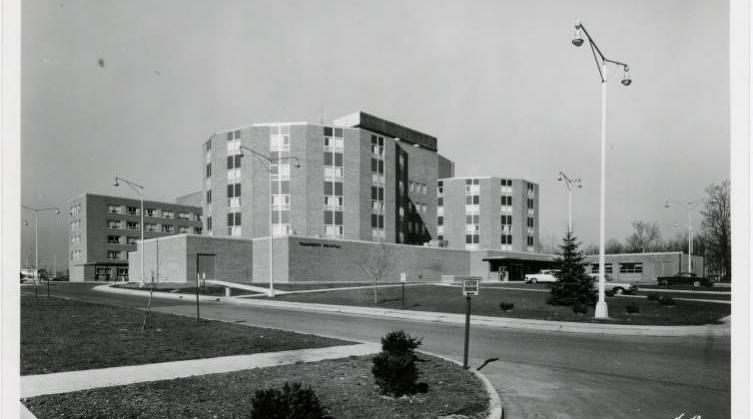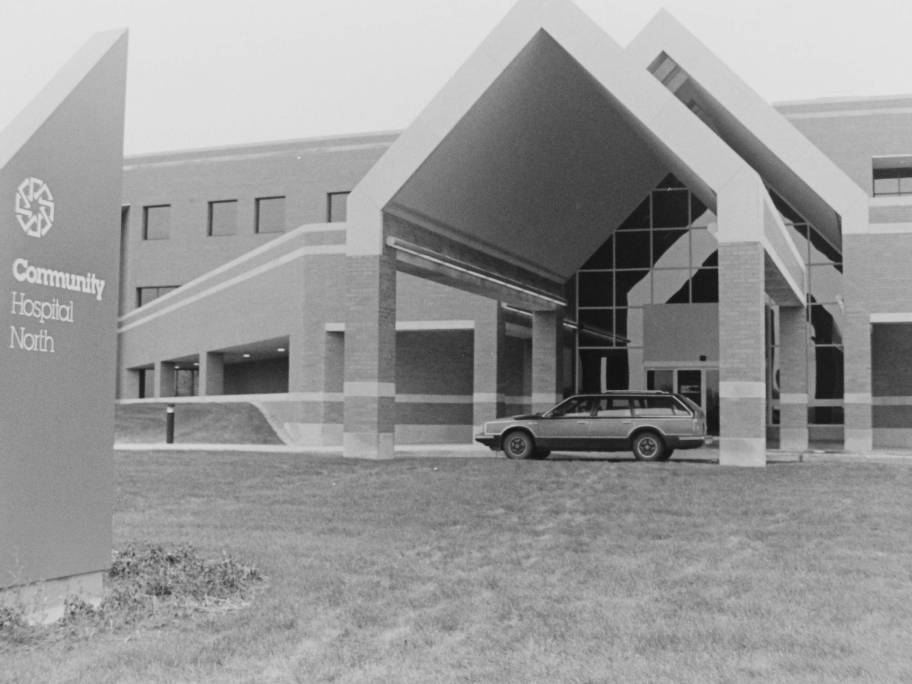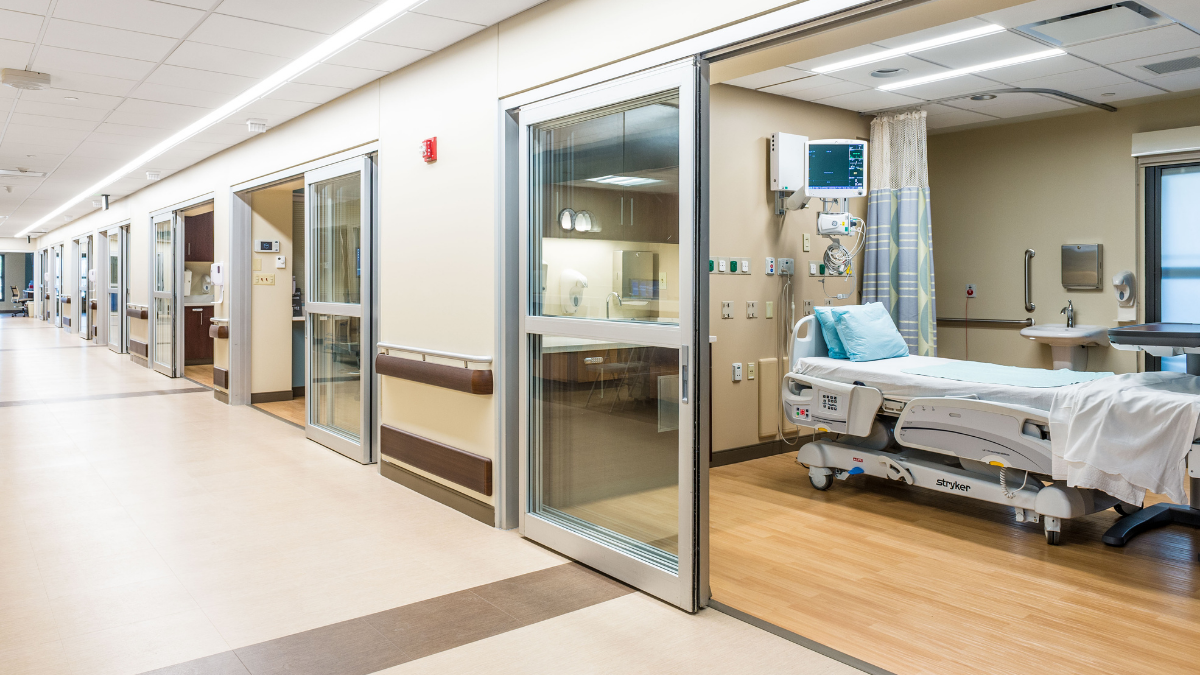With nine hospitals and more than 200 health care sites, the Community Health Network was the second-largest health care network in Indiana as of 2020. Only was larger. Community, however, had the largest primary-care network and provided more home-care services than any other health care system in the state. It counted 2 million patient encounters in 2019. With 328 beds, Community Hospital North was the network’s largest facility. The network also includes physician network locations, walk-in clinics, ambulatory health pavilions, ambulatory surgery and endoscopy centers, behavioral health locations, school-based sites, employer-based health clinics, and extended care facilities.

Community Hospital East, 1952-1982
After World War II, Indianapolis grew toward the suburbs. were crowded, and most were far from the citizens of the city eastside. To champion the cause of quality accessible health care for the entire city, Edward Gallahue led a concerned civic group to form the Indianapolis Hospitals Development Association. Part of the group’s challenge was to build a new eastside hospital on land donated by Gallahue for that purpose at 16th Street and Ritter Avenue.
Funding for the hospital came from business, industry, and private citizens. Volunteers conducted house-to-house campaigns. Employees in several companies donated funds through payroll deduction. Through all of these sources, fundraisers met the campaign goal of $20 million. The dubbed it “the swiftest, most effective fundraising campaign of our time.” Vice President Richard M. Nixon attended the groundbreaking for the newly named Community Hospital, which admitted its first patient on August 6, 1956. Wilbur McLin served as the first chief executive from 1955 to 1971.
In 1973, Community Hospital opened an outpatient mental health clinic and two satellite facilities in and counties, establishing the hospital’s commitment to mental health care. The clinic was named the Gallahue Mental Health Clinic in honor of Community Hospital’s founder. The clinic included a pathbreaking psychiatric unit for adolescents. It was the only one of its kind within the 36-county region in Central Indiana.
Community also innovated in the area of rehabilitative care. In 1974, the hospital opened the August J. Hook Rehabilitation Center. The 72-bed facility provided a full-time medical director who specialized in rehabilitative medicine and beds specially designed for rehabilitative care. At the time it was the “most broadly constructed rehabilitation program in Indiana,” and it partnered with such agencies as and . The Hook Rehabilitation Center moved to a new 63,000-square-foot, 60-bed facility on the northeast side campus in June 2013. Renamed Community Rehabilitation Hospital North, it was a joint venture of Community Health Network and Centerre Healthcare of Nashville, Tennessee.
Community Hospital North and Other Satellites, 1983-1995
Allen Hicks followed McLin and led Community until 1983. He and John “Jack” W. Heiney, who had served under General George Patton during World War II and as president of the , wanted Community Hospital to be more adaptive and innovative. They also understood that Community Hospital needed to provide access to care not only at its eastside location but also in other parts of Indianapolis. Heiney anticipated that the Indianapolis population was about to explode on the northeast side. Hicks, Heiney, and Community Hospital Vice President Bob Clarke first explored developing a new hospital at but finally settled on a 103-acre site north of .
In fall 1981, the Community Hospital board agreed to purchase the property for $25 million. Plans commenced for a 100-bed hospital, an outpatient clinic, and a 125-bed psychiatric facility. Community Hospital North opened on June 12, 1985. A new hospital CEO, William E. Corley, presided over grand opening events. The location of Community Hospital North provided easy access to residents of burgeoning Hamilton County towns, including Carmel, Fishers, and Westfield. The original hospital located at 1500 N. Ritter Avenue was renamed Community Hospital East.

Also in the 1980s, Community opened five MedChecks, urgent care clinics, for neighborhood residents’ immediate medical needs. In 1989 the city’s southside had become another area of rapid growth and development, and Community again expanded into a growing population. On September 25, 1989, Community acquired University Heights Hospital, Community Hospital South, with a commitment to expand services. Located at 1402 East County Line Road South, near Greenwood Park Mall, this hospital began a major expansion in 1992, adding maternity services, increased cardiology capabilities, and more. During the early 1990s, Community Hospitals in Indianapolis offered acute medical and surgical services at each hospital, as well as a variety of specialized health care programs.
Community Health Network, 1995-
Although health reforms proposed during the presidency of Bill Clinton did not come to fruition, the idea of mergers and acquisitions swept the healthcare marketplace in the 1990s. The Community board explored the idea of merging with . The two hospital systems announced that they would combine resources in fall 1994 as the St. Vincent Community Health Network. A slim majority of the Community board voted to terminate the proposed merger in August 1996. A possible merger with followed. Although neither of these mergers succeeded, Community Hospital Anderson, which had been the public hospital of and Madison County since 1962, joined Community Hospitals Indiana in 1996, and the name of the system changed to Community Health Network.
At Community East, the maternity unit in 1996 initiated its “Family Rooms” concept, which enabled women to stay in the same room for labor, delivery, recovery, and postpartum care (LDRP). LDRPs have the advantage of allowing mothers and babies to stay together without moving throughout their hospital stays. As of 2020, Community had one of the largest LDRP programs in the nation.
In 1997, the Balanced Budget Act cut Medicare funding, especially at hospitals like Community that provided physician medical education through residencies. As a result, most hospitals abandoned the practice of putting doctors on their payrolls, a practice that had become commonplace. In response, the Community Health Network established the first primary practice group in Indianapolis as a new way to align physicians with its hospitals. A Center for Interventional Radiology opened at Community Hospital East in 1999. At the time, it was the first of its kind in the Midwest and one of only a few in the U.S.
In 2003, the Community board voted to move its pediatric open-heart surgery services from Community Hospital East to Community Hospital North. On October 1, 2003, Community opened the Indiana Heart Hospital on its north eastside campus. It was one of the first all-digital heart hospitals in the U.S. Within one year the new Heart Hospital received recognition as a Thompson Reuters Top 100 cardiovascular hospital. Renamed Community Heart and Vascular Hospital in 2012, the hospital as of 2020 provided comprehensive cardiac care. It also included a cardiovascular genetic counseling center.
Although Community East lost pediatric and cardiovascular services, the Ritter Avenue campus in March 2007 opened the Community Regional Cancer Oncology Treatment Center, and in November 2007 it opened a 7,000-square-foot medical oncology center. On November 15, 2012, the Network announced that its Community Hospitals North and East were affiliating in an exclusive partnership with MD Anderson Cancer Network, located at the University of Texas.
Other mergers and partnerships ensued in the 2010s. Community finally saw a way to expand to the westside of Indianapolis by adding , the state’s only osteopathic hospital located at 3630 North Guion Road, to its system in 2011. The Network, however, had to take on $10 million in debt to do so. It also agreed to spend $7.5 million to provide needed upgrades. Community used this opportunity to develop additional outpatient centers in the area as well. Outside of Marion County, Community Howard Regional in Kokomo, Indiana, joined the Network in 2012.
When Marian University established its College of Osteopathic Medicine (MU-COM) in 2013, Community Health Network invested in the new program, seeing an opportunity to bring more doctors to Indiana and the Indianapolis area. As the state’s only osteopathic hospital, Community Westview seemed the ideal place to develop physician education programs in partnership with MU-COM. However, the Community Health Network’s plans for Community Westfield failed. By 2015, only one MU-COM student per month shadowed Westview’s physicians. With dwindling patient numbers, the Network suspended inpatient care at Westview in 2015. Community vacated the hospital when it closed its emergency department at the end of 2016. Community focused on outpatient care centers on the westside following Westview’s closure. MU-COM physician education continued at other Community Health Network sites.
Reinvestment in the Community Hospital East Campus, 2009-

With the decay of the economy of the eastside of Indianapolis, Community East became a beleaguered part of the system in the 1990s. The area lost jobs with the closure of manufacturing plants such as and . The closure of Fort Benjamin Harrison also brought a drop in employment. Between 2000 and 2010, emergency room visits at Community East had risen 68 percent, reflecting the deterioration of the hospital’s surrounding neighborhoods. The hospital was an aging facility that seemed to be threatened with closure.
Nevertheless, as the first hospital in the system, the Community Health Network looked for a way to save the Ritter Avenue location. Bryan Mills, who became Community Health Network CEO in May 2009, remained dedicated to serving the eastside. On May 14, 2015, the Community Health Network board approved a $175 million project to build a new hospital on the property. Mills saw the new hospital as a way not only to continue to provide much-needed health care services to the residents of the area but also to redevelop the community. Hospital and local civic leaders envisioned the project as a “new neighborhood gateway.” In addition to a new hospital complex, it included “gateway markers, improved medians with plantings and irrigation, upgraded signals,” better sidewalks, and a lot of landscaping in the area around Community East on Emerson Avenue between 16th and 21st streets. The official groundbreaking ceremony took place on August 19, 2015.

The old hospital facility continued operation while the new building was constructed. The demolition of two buildings happened first. The new patient tower, which was built on the footprint of the old building, replaced them. The first patients were moved into the new patient tower in February 2019. The old emergency building was then removed to make way for a new entrance. The project was scheduled for completion at the end of 2020. About 75 percent of the new complex was to be new construction.
Governor Mike Pence also designated Ritter Avenue for a new state-funded mental health facility, to replace . Groundbreaking for the new state-of-the-art NeuroDiagnostic Institute took place on August 22, 2016. Designed to take advantage of the most up-to-date genetic and imaging techniques, the 159-bed facility opened on March 13, 2019. The hospital dedicated 65 beds for pediatric and adolescent care. It also included an autism center. At the end of 2019, , one of the oldest addiction treatment hospitals in the U.S. located adjacent to the Community North campus since 1982, merged with Community Health Network. This merger made comprehensive psychiatrist treatment in both outpatient and inpatient settings available at Community facilities.
COVID-19, 2020
With the COVID-19 pandemic, income for the Community Health Network fell 48 percent during the first nine months of 2020. The health care network saw the highest drops in outpatient surgeries (23 percent), outpatient visits with physicians (21 percent), and inpatient surgeries (15 percent).

Help improve this entry
Contribute information, offer corrections, suggest images.
You can also recommend new entries related to this topic.




